How to make the perfect chelsea buns
The sticky bun is back. Is bread flour best, do you need lard and what kind of dried fruit should you use? Or are they just too Bunterish for modern Britons?
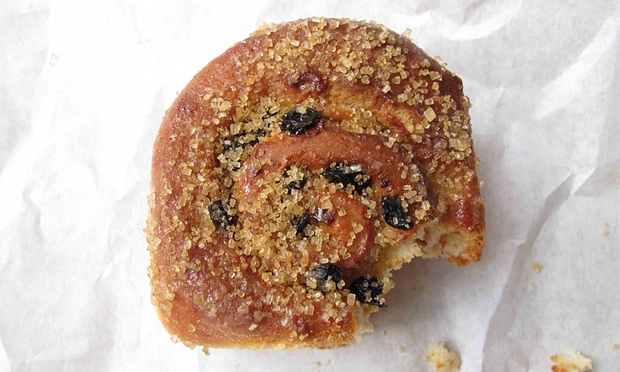
The perfect chelsea buns. Photograph: Felicity Cloake/Guardian
Elizabeth David describes the "small, soft, plump, sweet" Chelsea bun as an "English institution", but it is one that, like pints of mild or test cricket, seemed to be on the way out. How could a simple currant roll compete with the glamorous cupcake or the exotically unpronounceable kouign a mann? But, perhaps thanks to the Great British Bake Off (which also brought us the latter Breton speciality), the bun is back. And the chelsea version, apparently named after the famous 18th-century Bun House near Sloane Square in London, which counted the royal family among its patrons, is in the vanguard.
A Fitzrovia version is making waves at Honey & Co, central London; you can get gluten-free ones from GOD Bakery at farmers markets in north London; and M&S has just introduced some magnificent specimens nationwide. "Sugary, spicy, sticky, square and coiled like a Swiss roll", it is the chelsea that Jane Grigson described as "the best of all buns, on account of their buttery melting sweetness, and the fun of uncoiling them as you eat them". Best eaten warm from the oven, they are a prime candidate for home baking.
The dough
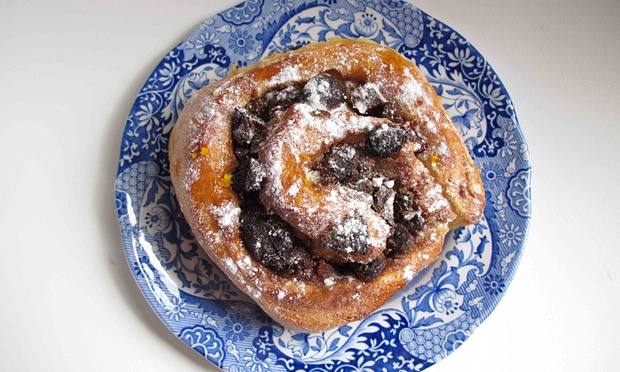
Paul Hollywood's chelsea bun. Photograph: Felicity Cloake/Guardian
Most recipes use strong white bread flour, but David bases hers on Elizabeth Raffald's 1769 bath buns, which claim that "whether ordinary household or strong bread, flour is not important". In fact, I find that plain flour gives a softer crumb, as well as being cheaper. Paul Hollywood's dough is the plainest, simply flavoured with salt, while the others I try all contain sugar, from Jane Pettigrew's scant teaspoon in her book Traditional Teatime Recipes to Michel Roux Jr's 75g. While a little sweetness is welcome, I prefer the bun itself to be fairly savoury to balance the filling.
David is the only one to add further flavourings to the dough, using lemon zest and cinnamon or mixed spice. A spiced dough sounds traditional then, but more importantly, it works better than adding the spices to the filling, as many of the other recipes I try suggest. Hollywood and Roux Jr's buns, in particular, are overpowered by powdered spice and zest in the centre, a fate avoided if you distribute these flavourings more evenly throughout the dough.
Liquids and fats
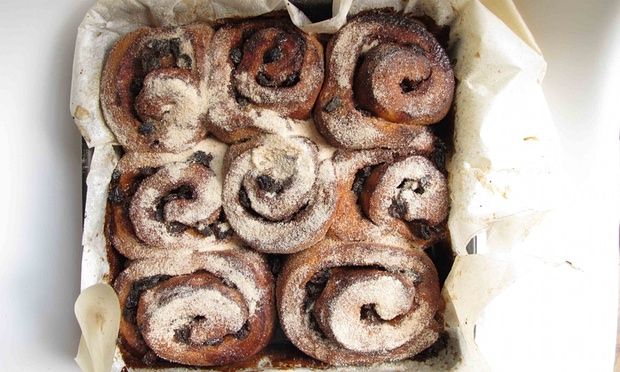
Lily Vanilli's chelsea buns. Photograph: Felicity Cloake/Guardian
Every recipe I try adds milk and eggs to the basic dough to make it soft and rich. Grigson mixes the milk with boiling water, but this makes the dough rather more bread-like than I think is ideal, while Lily Vanilli goes the other way in her book Sweet Tooth by ditching the whites in favour of more egg yolk. Her buns are indisputably delicious, but very, very rich – almost brioche-like.
Pettigrew is the only person to use lard rather than butter in her dough: the results are light and rather crisp, but lack the rich flavour of the others. That said, David's recipe is so extraordinarily buttery, containing six times as much as Hollywood's, that it reminds me unexpectedly of the aforementioned kouign amann. Her buns are utterly delicious, but flaky and dense rather than fluffy and light. I'd certainly recommend giving them a try, but not when you're after something light and fluffy for afternoon tea. Texture-wise, Ms Vanilli's (AKA Lily Jones's) buns are the proudest and fluffiest of the lot, making some of the other batches look rather small and mean, so I'll be copying her rough proportions. (Special mention to Hollywood's, which are also pretty good.)
Filling
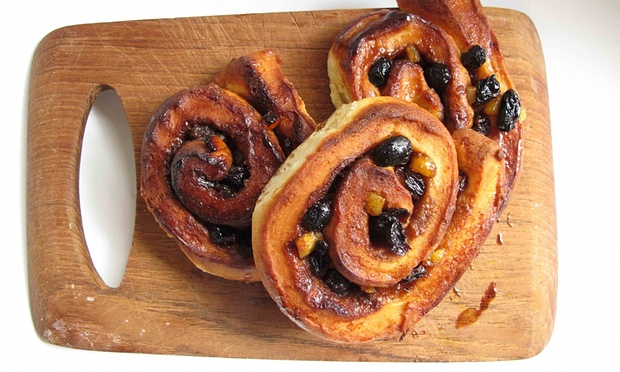
Jane Grigson's chelsea buns. Photograph: Felicity Cloake/Guardian
Like the cinnamon bun, which, thanks to the recent rash of Scandi worship, has stolen some limelight from the homegrown variety, the chelsea bun is a coiled dough filled with butter and sugar. Most modern recipes suggest melting the butter first, but I find it easier to use it softened, as David does; the generous quantities involved inevitably spill out the end in liquid form.
Vanilli and Grigson sprinkle dark brown sugar on top of the butter, Hollywood and Pettigrew use soft light brown sugar, Roux icing sugar and David just "brown sugar", for which I use demerara (for crunch). Lest you be worried that things were taking a turn towards the distinctly unhealthy, at this point the bun pulls its clean-eating trump card in the form of dried fruit. David suggests currants alone, Roux Jr sultanas (and not many), Grigson raisins, Vanilli sultanas or raisins soaked in Guinness overnight (for her slightly non-canonical hackney buns), Pettigrew raisins, currants and sultanas, and Hollywood an exuberant melange of sultanas, cranberries and dried apricots.
Indeed, there is so much fruit in Hollywood's buns that it spills from the dough as the buns unravel. All the larger dried fruits rattle around a bit in contrast to David's neat little currants, and though Vanilli's boozy soaked fruits are delicious, I find them a little disconcerting in this context. Instead, a certain chewiness proves a welcome contrast to the soft, fluffy dough.
Grigson and Pettigrew also add mixed peel, Roux Jr lemon juice (or perhaps zest, the instructions are unclear) and Hollywood orange zest. The peel works well, but as I have already added zest to the dough, I'm going to leave it out (the same goes for the spices Hollywood and Roux Jr sprinkle over at this point). I find the zests a little bitter in the filling, while the juice adds an unwelcome sourness. Simple is best.
Shaping and baking
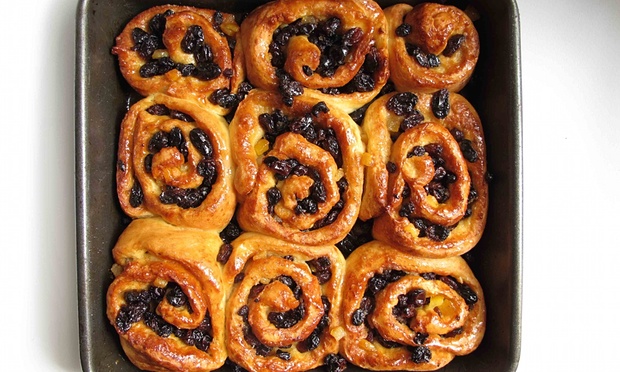
Jane Pettigrew's chelsea buns. Photograph: Felicity Cloake/Guardian
The shape of the chelsea bun is one of its chief attractions, that tempting swirl of dried fruit and sugar that guides the mouth inexorably to the centre. David's recipe incorporates the filling into the bun itself, folding it into the dough then rolling it out anew before rolling it up in the usual fashion. This has the advantage of keeping the fruit in as the dough rises, but as you lose the distinctive spiral, this is not a trade-off I'm willing to make.
Hollywood suggests pressing one side of the dough down on the counter before rolling it up, which makes the task slightly easier (though it's not tough either way, to be honest). Roux Jr and Grigson cook their buns at a very high temperature, which burns the fruit on top and leaves them quite dry. A slightly gentler bake, with a piece of foil on hand as Hollywood suggests, just in case the fruit starts to catch, seems wiser.
Finish
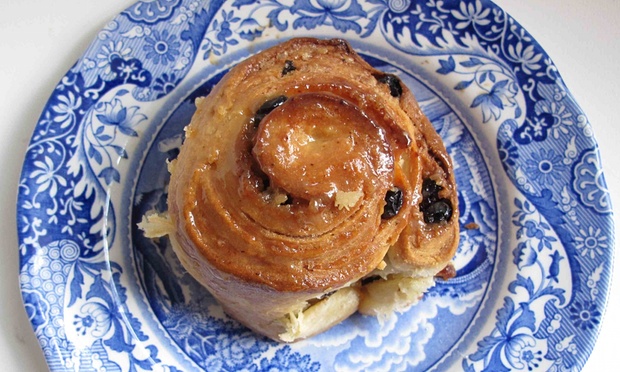
Elizabeth David's chelsea buns. Photograph: Felicity Cloake/Guardian
A good bun should be sticky and shiny, which means that some sort of glaze is essential; Roux Jr's look sad without it. Hollywood uses apricot jam, Grigson a sugar syrup, David a milk and sugar syrup, Vanilli the Guinness her fruit was soaked in and Pettigrew honey. All these work very well, with Vanilli's having a particularly interesting bittersweet flavour, but my favourite is David's slightly toffee-ish bun glaze, topped with crunchy demerara sugar rather than Vanilli's spiced sugar. Hollywood's zesty icing sugar, I realise belatedly, should have been an icing – that is what comes of second-guessing a silver fox. Sorry Paul. Eat while still warm for maximum sticky satisfaction.
The perfect chelsea buns
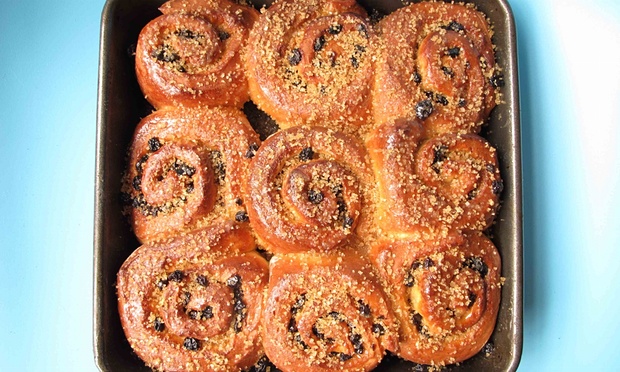
Perfect chelsea buns. Photograph: Felicity Cloake/Guardian
(Makes 9)-
200ml milk
60g butter
450g plain white flour
2 tbsp caster sugar
5g quick yeast
1 egg, lightly beaten
Zest of 1 lemon
1 tsp mixed spice
1 tsp salt
-
30g butter, slightly softened
35g soft brown sugar
100g currants
-
2 tbsp caster sugar
1 tbsp milk
2 tbsp demerara sugar
Put the milk and butter in a small pan and heat gently to just melt the butter – if it is hot rather than warm, set aside to cool slightly. Meanwhile, put the flour and sugar into a large mixing bowl and whisk to combine.
Whisk the yeast into the flour mixture, then pour in the warm milk and butter (no need to wash the pan) and the egg. Stir to combine in a soft dough, then mix in the zest, spice and salt.
Turn the dough on to a clean surface and knead well for about 10 minutes, until smooth and elastic. Put into a greased bowl, cover and leave in a draught-free place until doubled in size (one to two hours). Grease a tin about 27cm square.
Punch down the dough on a lightly floured surface then roll out to a rectangle about 25x35cm, making sure the longer side is facing you. Smear the butter across the surface, then scatter evenly with the sugar and currants.
Press the long end nearest you down on the work surface, then grab the other long end and roll it towards you as tightly as possible. Using a sharp knife, and pressing down on the sausage as little as possible, cut into nine pieces.
Arrange in the tin, evenly spaced out and not too close to each other or the edges, then cover and leave to prove until they are touching each other – 30-45 minutes. Meanwhile, heat the oven to 200C/400F/gas mark six.
Bake for 20-25 minutes until golden, covering with foil if the fruit starts to burn at any point. Meanwhile, warm the milk in the small pan you used to melt the butter and dissolve the caster sugar in it. When the buns come out of the oven, brush immediately with this glaze and scatter with the demerara sugar. Allow to cool before tearing apart. Best eaten on the day they are made.
Chelsea buns: too Bunterish for modern Britons, or a very welcome revival? And if you're an out and proud bun lover, which other traditional varieties would you like a perfect recipe for?